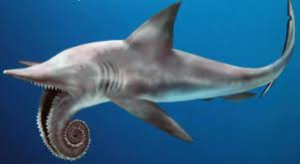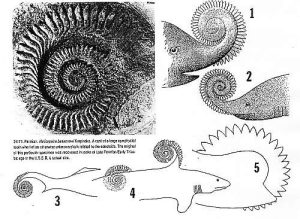You have to wonder how much we get right and how much we get wrong.
Danielle's PalaeoBlog
The Whorl Shark
This bizarre shark lived from the Carboniferous to the Triassic, and went extinct 225 million years ago. The Whorl Shark, or Helicoprion, is known for its distinct lower jaw. Most sharks shed their teeth throughout their life and have a constant conveyor belt of new teeth coming through. However, this shark maintained all its teeth, and just continued to grow more behind it, creating this spiral jaw. Fossil evidence shows it may have grown up to 20ft long!

As sharks’ skeletons are made of cartilage, only their teeth will be preserved. So, when fossil evidence of this monster was found, most scientists thought it was the ancient cephalopod, the ammonite (the resemblance is there). As you can see by the image here, many different ideas were put forward as to where this whorl went. But, it was not until studying the jaw of a relative, Ornithoprion, was it found that the whorl shark’s teeth belonged to the lower jaw.
Danielle's PalaeoBlog
The Whorl Shark

This bizarre shark lived from the Carboniferous to the Triassic, and went extinct 225 million years ago. The Whorl Shark, or Helicoprion, is known for its distinct lower jaw. Most sharks shed their teeth throughout their life and have a constant conveyor belt of new teeth coming through. However, this shark maintained all its teeth, and just continued to grow more behind it, creating this spiral jaw. Fossil evidence shows it may have grown up to 20ft long!

As sharks’ skeletons are made of cartilage, only their teeth will be preserved. So, when fossil evidence of this monster was found, most scientists thought it was the ancient cephalopod, the ammonite (the resemblance is there). As you can see by the image here, many different ideas were put forward as to where this whorl went. But, it was not until studying the jaw of a relative, Ornithoprion, was it found that the whorl shark’s teeth belonged to the lower jaw.
